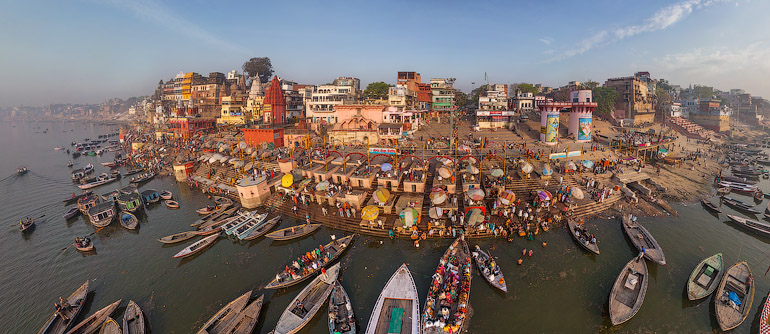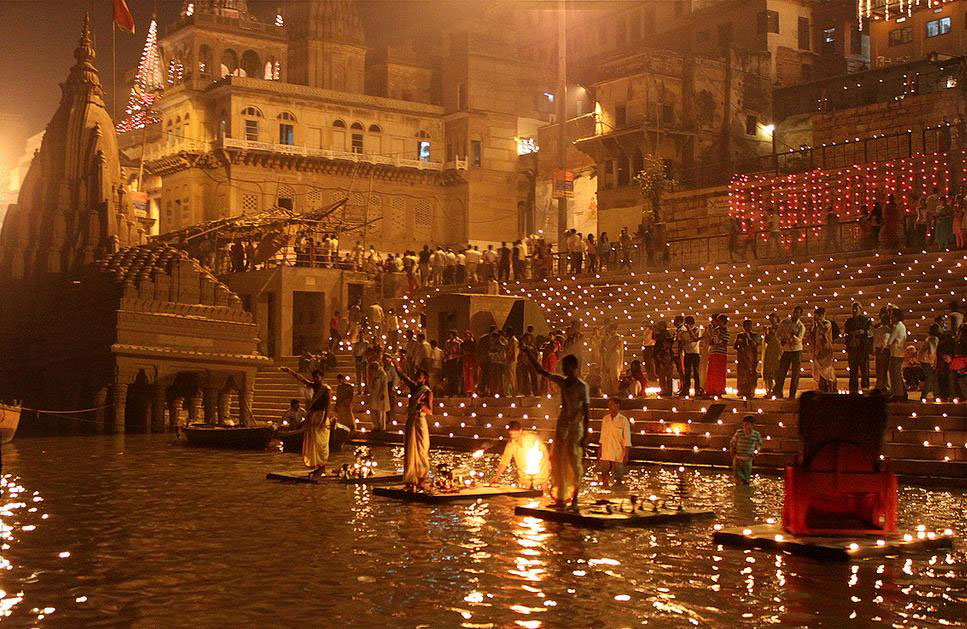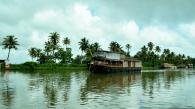Recently Added Places
Chimney is a scenic settlement 8 km away from Kurseong and just about a few kilometers...
The Rann of Kutch, also known as the Great Rann of Kutch (there's a Little Rann of Kutchas...
Known as the Queen of the Arabian Sea, Kochi was an important spice trading centre on the west...
User login
Varanasi
Varanasi, once known as Benares or Banaras and Kashi, is a historical city in northern India. The city is sacred to Hindus and Jains and also one of the oldest continuously inhabited cities in the world, with settlements dating back to the 11th century BC. Many Hindus believe that dying in Varanasi brings salvation/nirvana and so they make the trip to the city when they realize that they are close to death. For some, the culture shock of the burning corpses in plain view and the feces overflowing from the Ganges can be a bit overwhelming. However, the scene of pilgrims doing their devotions in the River Ganga at sunrise set against the backdrop of the centuries old temples is probably one of the most impressive sights in the world. The city can be scorchingly hot in the summer months so, if possible, time your visit to fall between October and March, and bring something warm to wear for chilly days and nights, instead.


By plane
Lal Bahadur Shastri Airport (IATA: VNS) is located 25km northwest of the city center. A taxi to/from the airport takes an hour and costs ₹750, while a tuk-tuk/auto-rickshaw can take twice as long and costs ₹500. Allow extra time due to traffic. Air India [2], JetKonnect [3], SpiceJet [4], and IndiGo [5] all operate regular flights to Delhi, Mumbai, Kolkata, Bengaluru, Hyderabad, Khajuraho, and Visakhapatnam. There are flights to Kathmandu on Buddha Air, flights to Colombo on Mihin Lanka Airlines, and flights to Bangkok on Thai Airways.
Its easy to get a state-run bus to city center, which costs less than half a dollar. Bus stand is 10 minutes walking distance from airport.
By train
There are multiple daily services to cities including Delhi (13 hours), Agra (13 hours), Lucknow (7 hours), Mumbai, and Kolkata.
Varanasi is served by three major railway stations:
Varanasi Junction (IR station code : BSB) - the trip between the train station and the Ganges-area costs ₹100 in a tuk-tuk.
Manduadih Railway Station - the trip between the train station and the Ganges-area costs ₹100 in a tuk-tuk.
Mughal Sarai Junction (IR station code : MGS), about 20km east of the city - the trip between the train station and the Ganges-area costs ₹500 in a taxi.
Varanasi is not a city with distinct tourist destinations; the experience is in watching the spectacle of life and death on the river and meandering through the alleys of the old city.
Ghats and the River Ganges
Floating away
While the use of ghats for cremation is well known, they are also used to give last rites to those who do not need cleansing by fire to purify their soul, including young children and pregnant women. Instead, their bodies are wrapped in cloth, weighted with stones and eased into the Ganga. However, it is fairly common for the ropes to give way, resulting in putrefying corpses washing up on the east shore across from the city. Steer clear if squeamish.
Dasaswamedh Ghat (main ghat)
The River Ganga is a sacred river for the Hindus and you will see traditional rituals and bathing occurring at all times of the day. On the Eastern banks, the River Ganga is flanked by a 300m wide sand belt, beyond which lies a green belt, a protected area reserved for turtle breeding. The western crescent-shaped bank of the River Ganga is flanked by a continuous stretch of 84 ghats, or series of steps leading down to the river, stretching for 6.8km. These ghats were built by Hindu kings who wanted to die along the Ganges, and they built lofty palaces along the river, most of which are now hotels, to spend their final days. You can walk along the river and see all of the ghats, but the best option for viewing the ghats is to charter a boat and see them from the river.
Hindus consider it auspicious to die in Varanasi, so some ghats are known as burning ghats, where over 200+ corpses per day are cremated in full view before their ashes are eased into the Ganga.
Some of the most popular ghats, from north to south:
Panchganga Ghat - the meeting of the five rivers
Manikarnika Ghat - the main cremation ghat; a must-see, but remain quiet and never take photographs (note: scams are plentiful here; see the "Staying Safe" section)
Dasaswamedh Ghat - known as the 'main' ghat, this is the site of the large evening aarti ceremony
Rana Ghat
Kedar Ghat - brightly painted in stripes and busy with bathers, very photogenic
Narad Ghat - the ghat on which bathing with spouse is not advised because the legend of contention
Harishchandra Ghat - the cremation place where Raja Harishchandra did the last rituals of his son.
Hanuman Ghat
Shivala Ghat
Tulsi Ghat - site of the large water purification plant
Assi Ghat - a popular place to stay, with many hotels, restaurants, and internet cafes
Religious buildings
New Vishvanath Temple at BHU
Alamagir Mosque, (overlooking Panchganga Ghat). a great place for a bird's eye view of the area.
Durga Temple.
Gauri Matha Temple. The devi at this temple is supposed to be the sister of the lord Kashi Vishwanath. Its a tradition to visit here just before you leave Kashi. You buy sea shells at this place and offer them to God saying that the virtues of donating the shells goes to her while you keep the virtues of having visited the holy shrines in Kashi and bathing in the ganga. The trip to Kashi is expected to yield results only after completing this custom.
Kaal Bhairav Temple. Dedicated to Kaal Bhairav, a dreaded form of the Lord in Shiva avatar symbolizing death. Its a tradition to buy a black thread (Rs. 15), sanctify it in the shrine, then wear it on the arm, wrist or around the neck as protection against evil.
Nepali Hindu Temple, (near Lalita Ghat). A small golden temple, built in Nepali architecture
Shri Kashi Vishwanth Temple (Golden Temple), [6]. Security is tight making entrance difficult and sometimes completely off limits to foreigners. No bags, cellphones or pens are allowed. They can be deposited in the shops by the temple entrance. The temple was destroyed multiple times by Mughal invaders and was re-constructed by Hindu kings who followed them.
Sankat Mochan Temple. The famous Hanuman temple, home to thousands of monkeys. Securiy is tight, mobile phones, keys etc. are not allowed inside the temple as a result of moslem terrorist bomb blasts; and as you enter you will be greeted by the sight of hundreds of monkeys on the premises. Beware- they may snatch from you if they see you carrying boxes or packets of food. Inside the temple you will find stacks of hanuman chalisa text for the use of devotees.
Sarnath (10km from Varanasi) - It is believed that in Sarnath Buddha gave his first sermon to his disciples after getting enlightenment. There is also a Museum in Sarnath. The location is also known as Deer Park. Sarnath is 13 Km from Varanasi and is very peaceful. Several Asian countries have built Buddhist temples there following their own ancient architectural traditions.
Tulsi Manas Temple.
Other sights
Ramnagar Fort
Banaras Hindu University, [7]. A very green and peaceful campus. Few actually know that this University was built during the Indian freedom struggle and is known as Oxford of the East. This is the largest residential university of Asia, with 124 departments. You can also visit Bharat Kala Bhavan, a museum of Art and Archeology inside the university. There is also a huge white marbled temple called Vishwanath Temple which was bulit by Pt. Madan Mohan Malviya, the founder of the university.
Chunar Fort, (15km southwest of Varanasi). A 2,000+ year old fort.
Kriti Gallery, Raman Niwas, Mahmoor Ganj, Varanasi (opposite All India Radio Station), ☎ 9839058007, [8]. 11-6 pm. A place to interact with contemporary art in the city of Varanasi.
Man Mandir Observatory.
Ramnagar Fort, (Located on the eastern bank of the river, opposite Tulsi Ghat). The fort of the King of Kashi. Built in 1750 in the Mughal style.
The most interesting area to stay is around the ghats, which are the main attractions for foreigners and are close to the religious attractions. However, this area is extremely noisy and many accommodation choices here are subpar, so do some research before you book. An alternative to staying in Varanasi is to stay near the main train station (Varanasi Junction). This area has some very nice new places popping-up in the recent years and is only about 10 minutes on a tuk-tuk. Another alternative is the much quieter Sarnath, 10+ km from Varanasi, but it takes 75+ minutes each way to reach Varanasi by tuk-tuk (₹200).
Some budget accommodations advertise free morning and evening boat rides along the river. However, the boat will take you up the river and then let the passengers know that for the return trip, there is a fee of ₹60 per person. Those who do not want to pay can get out of the boat and walk back.
Beware that Varanasi, particularly during summer, is prone to many hours of power outages a day. It is best to double check that your fan or A/C is run from a backup generator, or you may not have it for much of the day.
Eat
Banarasi Khana, or local delicacies, are known for their flavors. Many dishes here are flavored with asafoetida, ginger, bay leaves, cloves, cardamom, cinnamon, and/or dried fenugreek leaves.
Benares Dum Aloo is different from the dum aloo cooked elsewhere in India because the potatoes are stuffed with and cooked in a gravy that includes jaggery, fennel, and chili paste.
Varanasi is also known for its street food and chaat vendors. Aloo chaat is very common.
Varanasi Paan is famous all over India and the world. Paan is an assortment of flavors wrapped in a betel leaf. There are two versions: One that includes tobacco, and one that includes only sweet flavors. The exact ingredients depend on how much you offer, which can be as little as ₹10 or as much as ₹300. To eat the sweet version, shove the entire leaf in your mouth at once and chew until you swallow!
Rabri Malai Balai is a popular dessert in Varanasi that includes milk, sugar, almonds, and pistachio nuts. You can find it served in hole-in-the-wall or sweet shops.
There are plenty of food outlets with a very dynamic range in quality. The restaurants closer to the ghats cater more to foreign tourists, with variable success.
Drink
Alcohol is not common in Varanasi, but it is available at a few restaurants and hotels, such as the Radisson and Taj. There are several wine shops in the old city but they don't offer any sitting arrangement. You can buy whatever you want and bring it to your hotel room.
Bhang is a potent, powdered form of marijuana often mixed into "special" lassis, simply called bhang lassi. The drink is especially popular on holidays as Varanasi is a major center of Shiva worship as it is offered to the lord in form of Prashad. It can be quite intoxicating.
Thandai is cool milk based drink made with pistachios, almonds and kesar and topped off with a large dollop of malai (cream). Bhang is often added to thicken the concoction, though it can be made without. Many Tandai stores are located near the main Godowlia, and most also serve lass
Stay safe
Ganges
- Log in to post comments



